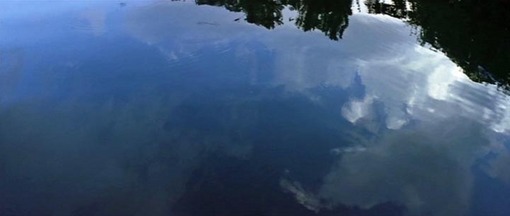From David Nicol:
The camera drifts slowly across a stretch of calm water. Insects and birdsong can be heard. Raindrops begin to strike the water’s surface as we pass over a patch of water weed. And in voice-over, a young woman says, “Come spirit, help us sing the story of our land. You are our mother; we, your field of corn. We rise from out of the soul of you.”
This is the opening shot of “The New World” (2005), Terrence Malick’s dream-like interpretation of the founding of the Jamestown colony in Virginia. The film depicts the interactions between the English colonists and the Powhatan natives, and in particular the relationship between John Smith and Pocahontas, who speaks the film’s opening words. As an opening shot, this image of placid river water is less spectacular than many of those that we have studied for Jim’s project, but its simplicity is deceptive and it contains all of the qualities of a great opening shot that Jim has been encouraging us to see.

The camera shoots the water from the point of view of someone gazing over the side of a shallow, drifting boat. It has an exploratory feel: we are surveying the water, studying it, so that even though it is Pocahontas who provides the voice-over, the explorer Smith is also subtly present. But this is not the gaze of someone who is simply staring at the surface of the water. The gazer is looking deeper, into the river’s heart. At first, we see nothing of what lies beneath the water’s surface, because blue sky and trees are reflected onto it. But as the shot continues, the reflection fades, and we see underwater a thick layer of green plants, whose tips eventually stipple the water’s surface. Sky, water, and plants exist together, all in one shot. When combined with the din of the insects and birds, it’s an image that plunges us from the outset into the beauty and the fecundity of the natural world, and Malick will continue to emphasize that theme throughout his film.

But the idea of looking deep into the river has further significance. This shot is our introduction to the network of waterways upon which most of the film’s events will take place. The credits sequence that follows this shot will display animated versions of John Smith’s maps of the rivers of Virginia. Following that, we will see images of the Powhatan people swimming in the river and (in the ‘Extended Cut’ of the film) Pocahontas’s voice-over will refer to the spirit-mother as “the great river that never runs dry”. As the swimmers rise to the surface (from out of the soul of her), they will see, coming up the river, the three ships of the Virginia Company. The Englishmen will build the colony of Jamestown on the banks of the river. So the river water that we see in this opening shot is not only the source of the Powhatan sense of origin, but also of the colony of Virginia that will ultimately become the United States. Everything comes from the river. And Malick will underscore this in the music that he chooses to accompany the arrival of the ships: the prelude to Wagner’s opera Das Rheingold, which opens with the three Rhine-Maidens swimming in a river at the beginning of the world.

This is a film about the arrival of change, change that is sometimes fascinating and sometimes catastrophic. Malick evokes these impending transformations at the end of the shot. The crystalline water is disrupted as first one, then several, then many raindrops hit it. As the rain strikes, the river trembles, and just as the shot ends, we hear the roar of crashing waves. Sound and image are warning us that something is coming (to quote another great cinematic opening sequence, “The world is changed; I feel it in the water”). I don’t think the raindrops are an entirely disquieting image, though; rain gives life as much as does the river. That ambiguity is fundamental to “The New World,” whose title describes both Smith’s discoveries in Virginia and Pocahontas’s in London, and which concludes with a revelation that the spirit mother is everywhere, even on the banks of a muddy English stream.

Beautifully done, Dr. Nicol — thank you! What a deeply mysterious opening it is, beginning with a reflection on the placid surface of the water that looks like an upside-down Impressionist landscape illuminated through Magritte’s “Empire of Light” — European and/or Native American, depending on your sphere of reference. And as we begin to realize that we’re moving over the water, we begin to see not only the disruptions on the surface, but, as you say, the world beneath it — very much a new world, as in prehistoric, untouched. The next shot is (we assume) of the speaker, Pocahontas, herself, gazing in the opposite direction, toward the sky with her arms outstretched. Following the credits (patterned on old navigational maps), we are below the water, swimming with the fishes and the people who live here…
And it ends with the camera gazing up at the tree of life — a whole forest, really — as a bird, silhouetted against the sky, swoops fleetingly through the frame.
Note to MZS: I’d still love to read your take on it too, Matt!












